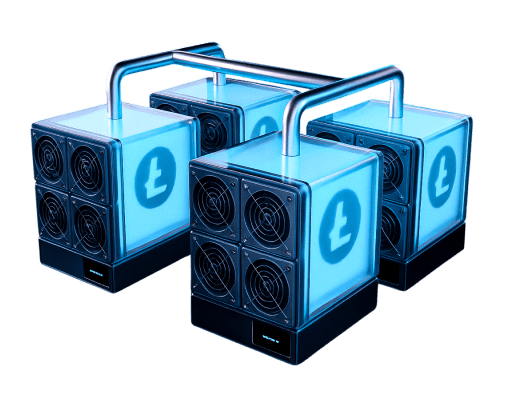Litecoin Mining in 2025: The Best Litecoin Mining Software.

Best Litecoin Mining Software for Windows, MacOS & Linux
Mining is one of the most profitable opportunities to earn cryptocurrency directly.
In Proof-of-Work blockchains, such as Litecoin, miners play a crucial role in validating transactions and securing the network.
The process of Litecoin mining requires both hardware and software components.
These software components are compatible with major operating systems, including Windows, macOS, and Linux.
Litecoin's reputation for stability, long-term standing, speed, and low transaction fees makes it an excellent option for anyone interested in mining, including beginners.
In this guide, we will explore the step-by-step process of mining Litecoin, the best Litecoin mining software for the major operating systems, factors to consider when choosing a mining software, and the advantages of Litecoin mining.
What is Litecoin Mining?
Litecoin mining is the process of validating incoming blockchain transactions, creating a new block of transactions, and adding the new block to the existing chain of blocks in chronological order.
Miners compete by solving complex computational puzzles, and the winner gets to validate the following transactions and add the new block.
For every new block added, the miner is rewarded with 6.25 LTC. This reward is expected to be reduced to 3.125 LTC by the next Litecoin halving, which is projected to occur on August 27, 2027.
Litecoin employs the Scrypt hashing algorithm, which is less resource-intensive compared to Bitcoin's SHA-256.
Although Scrypt is compatible with specialized hardware like Advanced-Specific Integrated Circuits (ASICs), it can also run on less intensive hardware like Graphic Processing Units (GPUs) and Central Processing Units (CPUs). This makes Litecoin mining more accessible to individual miners with less capital compared to Bitcoin.
How To Mine Litecoin: Step-by-Step
Litecoin mining involves the use of suitable hardware devices, Litecoin-supported mining software, and a Litecoin wallet.
Here's a step-by-step guide on how to mine Litecoin
Choose your Hardware
To mine Litecoin, you will need to select suitable hardware. Specialized mining hardware, such as Advanced-Specific Integrated Circuits (ASICs) and Field Programmable Gate Arrays (FPGAs), is more efficient for mining, generating higher hash rates within shorter periods.
Other suitable hardware includes Graphics Processing Units (GPUs) and Central Processing Units (CPUs). Although GPUs are less efficient than ASICs and FPGAs, they generate significantly higher computing power than CPUs.
Some of the best GPUs to mine Litecoin include:
- NVIDIA RTX 4090
- AMD Radeon RX 7900 XT
- RTX 3080 TI
Central Processing Units (CPUs) are compatible with the Scrypt Algorithm, and can therefore mine Litecoin. However, it is considered inefficient and inadequate, especially when competing with other miners with specialized and more powerful hardware.
If you are considering mining Litecoin with a CPU, here are some of the most powerful CPUs to consider:
- Intel Core i7/i9
- AMD Ryzen 7/9
- Apple Silicon Chips M1, M2,M3 & M4
Set Up Your Litecoin Wallet
You need a Litecoin wallet before you can start mining Litecoin. There are various types of Litecoin Wallets, including hardware, mobile, desktop, and paper wallets. Check out our comprehensive guide on how to select the best Litecoin wallet for you.
Select Mining Software
A mining software connects the hardware to the blockchain network. One must choose a mining software that is compatible with one's hardware and operating system. Other factors to be considered include interface, security, and reliability.
We will be exploring some examples of mining software in subsequent parts of the article.
Join a Mining Pool or Mine Solo
Mining can be done individually or jointly in a mining pool. In a mining pool, computing power from multiple miners is combined to solve the puzzle and generate hashes, as opposed to a solo miner who relies solely on the computing power of his hardware.
For mining pools, mining rewards are distributed to participants based on their contributions. On the other hand, a solo miner receives their mining rewards in full.
You should decide whether you want to join a mining pool or mine solo.
Configure Mining Software
After selecting mining software, the next step is to configure it with relevant information.
The mining software will provide instructions on the information required for setup and configuration, which typically includes wallet address and pool settings (if you join a mining pool).
Start Mining & Monitor Your Mining Progress
After configuring your mining software and joining a mining pool, you are ready to start mining, if desired.
Start mining and monitor your mining progress by keeping track of hash rates, hardware performance, and temperature.
Adjust settings and strategies as needed to ensure efficient mining and maximize profits.
Best Litecoin Mining Software for Linux, Windows, and MacOS in 2025
Mining software is essential for mining operations and needs to be compatible with the operating system running on the mining hardware.
Here are some of the best Litecoin mining software for the major operating systems: Linux, Windows, and macOS.
CGMiner
CGMiner is one of the oldest and most popular mining software programs. It supports mining of Litecoin and other cryptocurrencies such as Bitcoin and Dogecoin.
CGMiner is an open-source and highly customizable mining software. However, it uses a command-line interface, which requires some technical knowledge and, as such, may not be suitable for beginners.
Newer versions of CGMiner support ASICs and Field Programmable Gate Arrays (FPGAs), while older versions support GPU hardware. CGMiner is compatible with Windows, Linux, and macOS.
Easy Miner
Easy Miner employs a Graphic User Interface (GUI), which provides a user-friendly and interactive interface, making it more suitable for beginners.
Easy Miner supports ASICs, GPUs, and CPUs. However, it can only run exclusively on Windows.
MultiMiner
MultiMiner is a less popular mining software, but it stands out as a good option for switching mining operations across devices.
MultiMiner offers a clean, beginner-friendly Graphic User Interface (GUI) which does not require special technical skills to navigate.
It supports ASICs, FPGAs, and GPUs, and can be run on Windows, Linux, and macOS. Though MultiMiner is heavily optimized for Windows, it may require additional setup or software to run on Linux and macOS.
BFGMiner
BFGMiner is a well-known mining software that was developed as far back as 2012. BFGMiner uses a command-line interface, offering advanced features and customization options. It is best suited for experienced miners.
BFGMiner was initially designed for FPGAs and only exclusively supports ASICs and FPGAs. It is compatible with Windows, Linux, and macOS.
BFGMiner supports mining of other cryptocurrencies such as Bitcoin and Dogecoin. It also allows mining of multiple cryptocurrencies simultaneously.
Awesome Miner
Awesome Miner is a robust mining software that allows miners to manage multiple mining rigs and pools from a single dashboard. It currently supports over 50 mining engines.
Awesome Miner supports ASICs, FPGAs, GPUs, and CPUs. It also has a web version that can be accessed from any browser on any device, including smartphones. It is only compatible with Windows and Linux operating systems.
Although Awesome Miner has a simple user interface, it has an extensive variety of tools and features, which may be overwhelming for beginners.
NiceHash
NiceHash is a mining platform that offers a variety of mining services, including mining, trading of computing power, and mining pools, among others.
NiceHash has a powerful mining software, NiceHash Miner, which supports numerous hashing algorithms, including Scrypt and SHA-256. It features a simple and user-friendly interface, along with a mobile app, enabling miners to manage and monitor mining operations remotely.
NiceHash Miner is primarily designed for Windows. To use NiceHash Miner on macOS or Linux, you have to download NiceHash OS. Moreover, it is compatible with ASICs, GPUs, and CPU hardware.
| Mining Software | Compatible Operating System | Compatible Hardware | Price | Beginner-friendly |
| CGMiner | Windows, Linux, & MacOS | ASIC, FPGA & GPU (older versions) | Free | No |
| Easy Miner | Windows | ASIC, GPU & CPU | Free | Yes |
| MultiMiner | Windows, Linux, & MacOS (requires additional software for Linux & MacOS) | ASIC, FPGA & GPU | Free | Yes |
| BFGMiner | Windows, Linux, & MacOS | ASIC & FPGA | Free | No |
| Awesome Miner | Windows & Linux | ASIC, FPGA, GPU & CPU | Free (for up to 2 miners) | No |
| NiceHash | Windows, Linux, & MacOS (requires additional software for Linux & MacOS) | ASIC, GPU & CPU | Free to install (but 2% of mining earnings is paid for Nicehash services) | Yes |
Is Litecoin Mining Profitable?
Litecoin miners are rewarded after every successful block created. However, the extent of mining profitability is dependent on several factors.
Choice of Hardware:
Specialized hardware such as ASICs generates more hashes than other hardware, like FPGAs, GPUs, and CPUs, thereby leading to a higher hash rate, increasing the chances of mining a new block and earning block rewards.
Hardware costs:
Mining hardware is quite expensive, but exceptionally efficient and high-performing. ASICs are considered the best hardware for mining, and they cost significantly more than FPGAs, GPUs, and CPUs. Other hardware expenses that may be incurred include costs of cooling and maintenance to ensure long-term and optimal performance.
Electricity Costs:
Mining operations require a substantial amount of electricity. Where electricity costs are high, it can significantly reduce or even consume all mining profits.
Mining Difficulty:
This refers to the complexity of mining a block on the Litecoin network. As more miners join the network and the hash rate increases, mining difficulty is adjusted to be higher to ensure stability of the network. Higher mining difficulty would require more computational power and time to mine a block. This can decrease the chances of earning block rewards or reduce mining profits.
Litecoin Price:
Miners are rewarded a fixed amount of LTC tokens after every successfully mined block. Where the market price of LTC declines, mining profit reduces, and vice versa. Therefore, mining profits largely depend on market price and volatility.
Mining Pool Fees:
As a participant in a mining pool, one is required to pay a percentage of mining earnings as pool fees. High pool fees can significantly reduce mining profits.
What Are The Benefits Of Mining Litecoin?
Litecoin mining offers several advantages and benefits to miners:
Financial Rewards
Litecoin mining can be very lucrative if carried out strategically. Miners are rewarded with a certain amount of LTC tokens after every successfully mined block. Miners also receive a part of the transaction fees paid by users to process transactions on the network. This creates an opportunity for miners to accumulate LTC for trading or to hold mid to long term.
Learning Opportunity
Litecoin mining provides miners with practical experience and an understanding of blockchain technology and decentralized systems. The Litecoin mining community also provides a forum to share knowledge, resources, and experiences.
Supporting the Litecoin Network
Miners play a crucial role in maintaining the security and integrity of the Litecoin network. By participating in the mining process, miners promote decentralization and enhance the network's security.
Technological Advancements
With the increasing complexity of mining, there have been more software and hardware advancements tailored to carry out mining operations effectively.
Mining serves as a key driver for the development of robust and energy-efficient mining hardware and software.
What To Consider When Selecting a Litecoin Mining Software
There are certain factors to consider when selecting mining software. Some of which include:
Compatibility: The Litecoin mining software must support the Litecoin blockchain and should be compatible with the selected mining hardware.
Pricing: Most Litecoin mining software is open-source and free to use, but may require a subscription to enjoy premium features. It is essential to decide whether to opt for the free or paid versions, considering the features they offer.
Interface: The interface of Litecoin mining software ranges from simple to advanced. Mining software that employs a Graphical User Interface (GUI) is often easier to navigate and requires no special technical skills or knowledge, compared to a command-line interface. Beginners are advised to select mining software with a user-friendly interface.
Customization: Depending on the scale of mining operations, one may need an interface with wide customizable options to manage mining operations effectively and optimize performance.
Security: It is essential to ensure the protection of the mining software before downloading or launching it. Mining software should only be downloaded directly from the official developer's website to avoid risks of malware or viruses.
Regular Updates: Regular updates to mining software could include security patches and technical features. This demonstrates the team's dedication to optimal performance and efficiency.
- Customer Support: It is advisable to use mining software with 24/7 customer support for quick and easy resolution of bugs or technical issues.
Conclusion
Litecoin mining remains a profitable venture in 2025 for anyone interested. Although Litecoin mining may require expensive hardware such as ASICs and FPGAs, cheaper alternatives like GPUs and CPUs are available for beginners looking to start mining Litecoin.
Moreover, choosing good mining software is also crucial for efficient mining operations. In making a selection, one must consider its compatibility with the operating system and the mining hardware for effective performance.
Miners must stay informed about mining programs and developments on the Litecoin network, devising tactical strategies to maximize profit despite the high mining costs.
Please be advised, that this article or any information on this site is not an investment advice, you shall act at your own risk and, if necessary, receive a professional advice before making any investment decisions.

 Farouk Ahmed
Farouk Ahmed